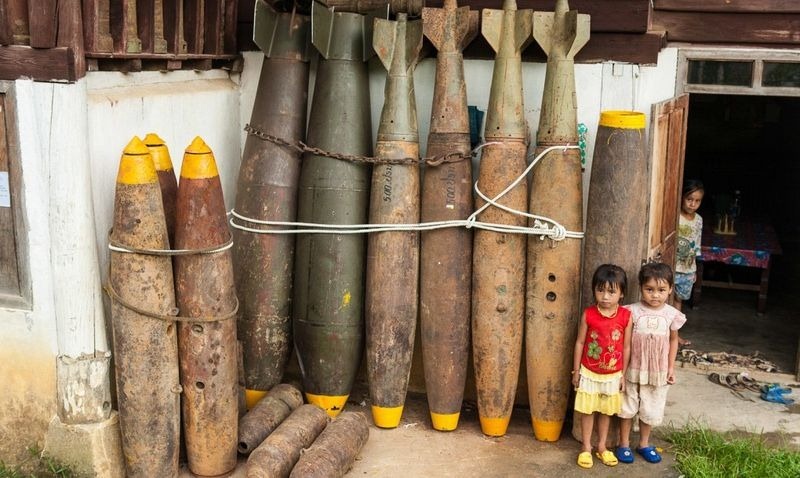The end of the Vietnam War wasn’t the end of the troubles that came after, especially for those living in Laos. During the war, in the period from 1964 to 1973, the US army dropped more than 270 million bombs over this small country. That is more than 2 million tons of bombs. Statistically speaking, a plane dropped bombs every eight minutes during 24 hours, for nine years. Up to this date, Laos is considered as the most heavily bombed country per capita in history.
But not all of those bombs exploded and even today, after 40 years, people are trying to clean all the mess that is caused by them. It is estimated that around 30% of the bombs failed to explode. Many of those are still buried in the ground, detonating in most unfortunate moments and places.
A majority of accidents happen when the local population tries to open the bomb casings while searching for scrap metal. Gathering this bomb scrap is a very dangerous occupation, but still, many people do it because it can bring good income. A bomb casing that weighs around 2000 pounds can be sold for more than 100 dollars. Even today there is an average of two casualties per week caused by live bombs or mines.
Besides the unexploded bombs lurking from the ground, you can also find empty bomb casings scattered all around the country. Today, this empty shells that once brought terror and mayhem, are being transformed into everyday objects. People are reusing them and giving them new functions.
Photographer Mark Watson took a bicycle trip across Laos and he was astonished by the things he saw. On the photos he took during the trip, you can see some amazing items that people created using the bomb cases. You can see them made into planter boxes, buckets, cups, cowbells, or even canoes and house foundations. It is ironic how these weapons that destroyed houses are now being used as their foundations.
![laos-bombs-mark-watson-11[2]](https://www.thevintagenews.com/wp-content/uploads/sites/65/2015/11/laos-bombs-mark-watson-112.jpg)
MAG (Mines Advisory Group) was the first organization that started working in the country in 1994. Over the past 10 years, they have cleared around 44 million square meters of land from unexploded cluster bombs. Their efforts still continue. David Hayter, of Mines Advisory Group (MAG) said:
“Lots of agricultural land is denied to people because of the presence of UXO (unexploded ordnance), and this is the main problem. It prolongs poverty because people can’t do what they need to do. If they know that UXO is present, they will not plow deeply enough to get a good quality crop.”
But many people are aware of UXO presence and continue to plow the land. As of 2012, at least 29,000 people have died from this kind of accidents.
Empty bomb casings used as house foundations
![laos-bombs-mark-watson-5[2]](https://www.thevintagenews.com/wp-content/uploads/sites/65/2015/11/laos-bombs-mark-watson-52.jpg)
A planter box made of a bomb casing
A bomb casing that is now being used as a water container
An empty casing reused as a boat
Fuel drop tanks from US military planes are being used as boats also
Children posing in front of unexploded bombs
Another example of casings being used as foundations for a house
Cowbells made of bomb scrap
A bomb casing used as decoration in front of a house
Source: inhabitat, amusingplanet, MAG

![laos-bombs-mark-watson-4[2]](https://www.thevintagenews.com/wp-content/uploads/sites/65/2015/11/laos-bombs-mark-watson-42.jpg)
![laos-bombs-mark-watson-6[2]](https://www.thevintagenews.com/wp-content/uploads/sites/65/2015/11/laos-bombs-mark-watson-62.jpg)
![laos-bombs-mark-watson-10[2]](https://www.thevintagenews.com/wp-content/uploads/sites/65/2015/11/laos-bombs-mark-watson-102.jpg)
![laos-bombs-mark-watson-1[6]](https://www.thevintagenews.com/wp-content/uploads/sites/65/2015/11/laos-bombs-mark-watson-16.jpg)
![laos-bombs-mark-watson-2[2]](https://www.thevintagenews.com/wp-content/uploads/sites/65/2015/11/laos-bombs-mark-watson-22.jpg)
![laos-bombs-mark-watson-8[2]](https://www.thevintagenews.com/wp-content/uploads/sites/65/2015/11/laos-bombs-mark-watson-82.jpg)
![laos-bombs-mark-watson-7[2]](https://www.thevintagenews.com/wp-content/uploads/sites/65/2015/11/laos-bombs-mark-watson-72.jpg)
![laos-bombs-mark-watson-3[2]](https://www.thevintagenews.com/wp-content/uploads/sites/65/2015/11/laos-bombs-mark-watson-32.jpg)
![laos-bombs-mark-watson-9[2]](https://www.thevintagenews.com/wp-content/uploads/sites/65/2015/11/laos-bombs-mark-watson-92.jpg)